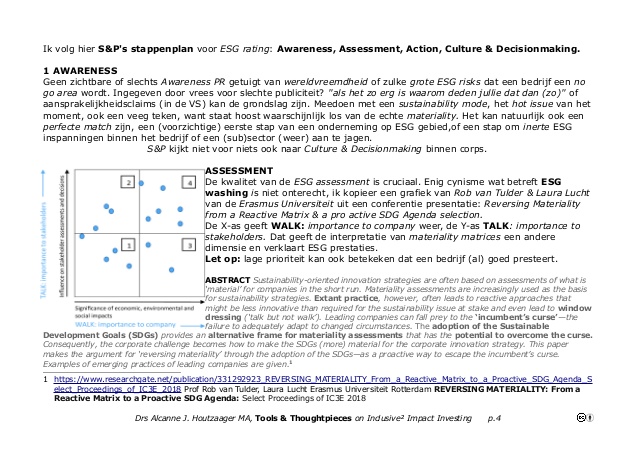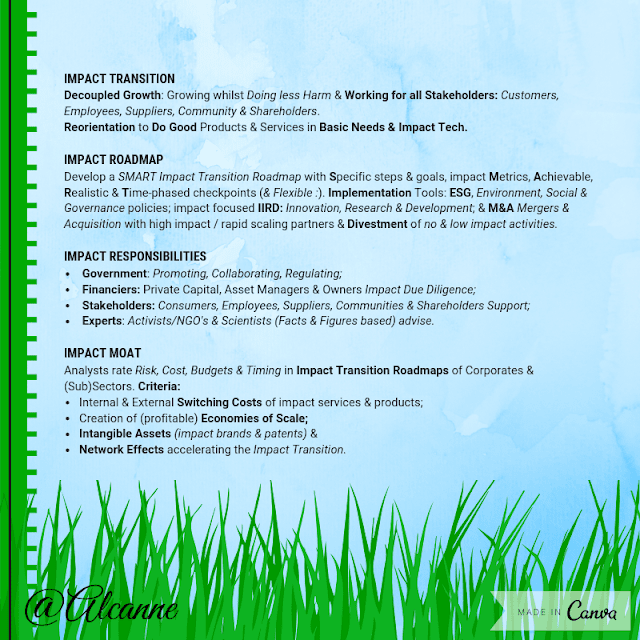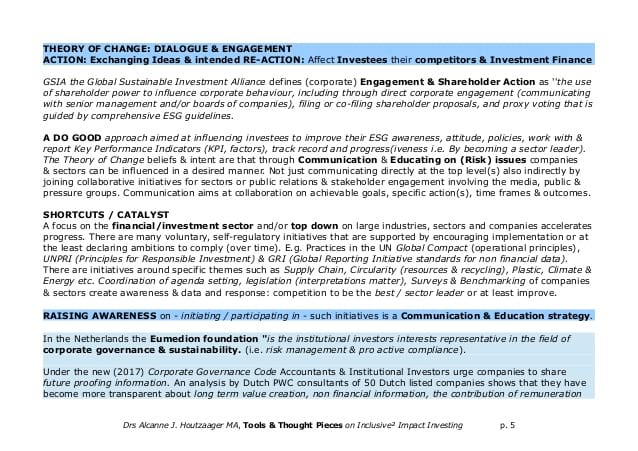Deze post leest makkelijker op Slideshare
27 december 2019
8 december 2019
Big Food Investing & Divesting
Shooting for STARS & Ditching DOGS
Verkoopt Big Food haar ongezonde assortiment?
De Stranded Assets in Food?
Clearing House of Bad for You #DoNoHarm
Wat koopt het ? Better for You: #DoLessHarm?
of Good for You: #DoGood?
Investeringen in ESG van Food & Beverages (F&B), leveren de grootste bijdrage aan de UN GlobalGoals, #SDGs met aan kop Agriculture. Meat, Dairy & Poultry staan op de derde plek na biotech & pharmaceuticals.
Dat lijkt in strijd met versnelling van het marktaandeel van vleesvervangers, het enthousiasme voor Beyond Meat's IPO en al het nieuws over concullega's, investeringen, merk & product lanceringen etc.
Ik kijk naar Unilever, Nestle, Danone, Kellog's & General Mills en hun materiality matrix als quick scan van de ESG & langere termijn impact ambities & prioriteiten.
Hun Venture Capital Fund investeringen leveren de meeste informatie over kortere termijn doelen.
pagina 9-32 op
https://www.slideshare.net/alcanne/bigfood-divesting-investing-for-impact-mand-a-vc-184730357
Verkoopt Big Food haar ongezonde assortiment?
De Stranded Assets in Food?
Clearing House of Bad for You #DoNoHarm
Wat koopt het ? Better for You: #DoLessHarm?
of Good for You: #DoGood?
Investeringen in ESG van Food & Beverages (F&B), leveren de grootste bijdrage aan de UN GlobalGoals, #SDGs met aan kop Agriculture. Meat, Dairy & Poultry staan op de derde plek na biotech & pharmaceuticals.
Dat lijkt in strijd met versnelling van het marktaandeel van vleesvervangers, het enthousiasme voor Beyond Meat's IPO en al het nieuws over concullega's, investeringen, merk & product lanceringen etc.
Ik kijk naar Unilever, Nestle, Danone, Kellog's & General Mills en hun materiality matrix als quick scan van de ESG & langere termijn impact ambities & prioriteiten.
Hun Venture Capital Fund investeringen leveren de meeste informatie over kortere termijn doelen.
pagina 9-32 op
https://www.slideshare.net/alcanne/bigfood-divesting-investing-for-impact-mand-a-vc-184730357
Glossary Inclusive Impact Investing
LINKS on: https://www.slideshare.net/alcanne/impact-investing-glossary-terms-definitions
https://image.slidesharecdn.com/impactinvestingglossarytermsdefinitions-190927073451/95/impact-investing-glossary-terms-definitions-2-638.jpg?cb=1569570110

https://image.slidesharecdn.com/impactinvestingglossarytermsdefinitions-190927073451/95/impact-investing-glossary-terms-definitions-3-638.jpg
https://image.slidesharecdn.com/impactinvestingglossarytermsdefinitions-190927073451/95/impact-investing-glossary-terms-definitions-4-638.jpg?cb=1569570110
https://image.slidesharecdn.com/impactinvestingglossarytermsdefinitions-190927073451/95/impact-investing-glossary-terms-definitions-5-638.jpg?cb=1569570110
https://image.slidesharecdn.com/impactinvestingglossarytermsdefinitions-190927073451/95/impact-investing-glossary-terms-definitions-6-638.jpg?cb=1569570110
https://image.slidesharecdn.com/impactinvestingglossarytermsdefinitions-190927073451/95/impact-investing-glossary-terms-definitions-2-638.jpg?cb=1569570110

https://image.slidesharecdn.com/impactinvestingglossarytermsdefinitions-190927073451/95/impact-investing-glossary-terms-definitions-3-638.jpg
https://image.slidesharecdn.com/impactinvestingglossarytermsdefinitions-190927073451/95/impact-investing-glossary-terms-definitions-4-638.jpg?cb=1569570110
https://image.slidesharecdn.com/impactinvestingglossarytermsdefinitions-190927073451/95/impact-investing-glossary-terms-definitions-5-638.jpg?cb=1569570110
https://image.slidesharecdn.com/impactinvestingglossarytermsdefinitions-190927073451/95/impact-investing-glossary-terms-definitions-6-638.jpg?cb=1569570110
25 september 2019
IMPACT MOAT
Beleggingsanalisten
gebruiken het begrip Moat -Engels voor de (soms) met water gevulde
slotgracht om een vesting- om de vooruitzichten van een
belegging/bedrijf te beschrijven ten opzichte van concurrenten.
De
term wordt o.a. gebruikt door rater Morningstar dat eer indices mee
bouwt. Moat is gebaseerd op 4(5) kenmerken : switching
costs, network effects, intangible assets, efficient scale (&
competitive & cost advantage). De rating schat de voorsprong op
de concurrentie van narrow
(smal) 0 of 1 jaar tot wide
(brede) moat
tot wel 20 of 10 jaar afhankelijk van de sector.
Het
bepalen van moat is een 'uitdaging' bij bijv. diversified largecaps
door het opereren op meerdere markten en in de hele wereld, laat
staan voor transformerende ondernemingen & snel opkomende,
veranderende sectoren.
Met
transformerend bedoel ik bedrijven die de Klimaat
& Impact transitie als strategie voor de
onderneming/sector omarmen en zich heruitvinden als Impact
Growth Stock. Het begint
met kosten-besparende activiteiten zoals het terugdringen van
negatieve impact door te besparen op grondstoffen, energie &
watergebruik, afval & etc.
Het evolueert naar nog steeds
kostenbesparende activiteiten met positieve impact in het
Safety&Health & personeelsmanagement
en door nieuwe diensten & producten met (meer) impact te
ontwikkelen. Dat
kan ook als
de traditionele, oorspronkelijke kernactiviteiten geen Basisbehoeften
of Impact Tech zijn. #DSM & #Philips.
MOAT:
Kwantiteit, score op UN SDG Goals?
Het
ligt voor de hand om de Impact
Moat = breed te bestempelen als veel
impact indicatoren worden beoogd & gemeten,
bijv. de 17(2
criteria)
Global Sustainable Development Goals van de VN voor
alle mensen, landen en ondernemingen: interne en onderlinge doelen.
Dat
kan voor (Sociale) ondernemingen en beleggingsproducten. De meeste
kijken ondernemingen en SDG/Global Impact indices meestal naar kern-
& operationele ESG activiteiten en kiezen dan een (focus) of
enkele SDGs. Moederindices met usual suspects. Bijv iShares
Global Impact en
Swells Impact 400.
VIGEO
EIRIS doet het iets ruimer voor de Wereldbank:
https://www.slideshare.net/alcanne/vigeo-eiros-sdg-thema-per-company
MOAT:
Kwaliteit, de diepte in bij een SDG
Een
andere praktijk van impact moat bepaling is bijv. Equality
& Diversity
indices/indexfondsen die kijken naar het aantal Vrouwen
in de Board
(1) & het Management
(2)
& (vastgelegd) beleid
(ambitie
& monitoring, 3).
ETFdbase heeft ESG data van MSCI en hanteert
voor de ESG score voor
ETFs op Board
Diversity: No
Female Directors, Three or More Female Directors & Females
Represent 30% of Director. https://etfdb.com/esg-investing/governance-issues/board-diversity/
Een
bredere moat voor bedrijven en indices is bijv. gebouwd op veel meer
relevante data, zoals de Nederlandse Equileap
index familie van vrouwvriendelijke bedrijven op basis van analyse
van
3000 bedrijven in 23 landen en
19
criteria.
A:
Gender Balance in Leadership and Workforce:
› Non-executive board › Executives › Senior management ›
Workforce › Promotion & career development opportunities;
B:
Equal Compensation and Work/Life Balance:
›
Fair remuneration › Equal pay › Parental leave › Flexible work
Options;
C:
Policies Promoting Gender Equality:
›
Training & career development › Recruitment strategy ›
Freedom from violence, abuse, & sexual harassment › Safety at
work › Human rights › Social supply chain › Supplier diversity
› Employee protection; &
D:
Commitment to Women’s Empowerment:
›
Gender Audit.
Meer
op https://equileap.org
Beide
MOAT interpretaties focusen op de bedrijfsvoering
& impact
Investing focust primair op kernactiviteiten
& dan bedrijfsvoering.
ESG
inspanningen van largecaps hebben door hun omvang grote 'do
less harm'' & ''do good'' impact binnen
de onderneming, de productieketen, maar
ook in de sectoren en landen waar zijn actief zijn als katalysator.
Elke
onderneming & investering moet bijdragen aan economische
groei: omzet & winst en werkgelegenheid.
De ontwikkelingsfase waarin een economie en/of sector zich bevindt is
doorslaggevend. De NL ontwikkelings-bank FMO investeert in projecten
die werkgelegenheid (1e impact metric).
Ondernemingen
in ontwikkelde markten (moeten) investeren in tech-nologische
ontwikkelingen zoals automatisering = minder zwaar & monotoon
werk + IRD, Refurbishing & Circulair Ondernemen.
IMPACT
MOAT: Kosten & Tijdspad
van de Transitie naar Impact (Growth)
Stock
Inspanningen voor Innovatie, Research & Development i.e. technologische vooruitgang die niet bijdragen aan (lange termijn) kostenbesparing & concurrentievoordeel zoals ESG inspanningen maar ook niet aan basisbehoeften & impact technologie zijn niet meer toereikend voor de evolutie naar Nieuw Kapitalisme.
Ondernemingen & Investeerders zullen moeten focusen op Societal Solutions, producten & diensten aanbieden voor basisbehoeften & de impact tech die basisbehoeften voor zoveel mogelijk mensen bereikbaar & betaalbaar maken.
Idealiter weten we precies welke technologische vooruitgang de meeste maatschappelijke (positieve) impact zal hebben. Al doende leert men. Het internet begon als defensie project, werd omarmd door de wetenschap voor kennisuitwisseling, vervolgens decades gedomineerd door pornosurfers voordat het miljarden mensen toegang gaf tot essentiële informatie & grootschalig werkgelegenheid & economische groei creëerde.
Omdat niemand in de toekomst kan kijken is Impact focused Governance de voor de hand liggende keuze van ondernemingen & sectoren. Zij hebben inzicht in de impact van hun diensten & producten & productiewijze & hun (netto) toegevoegde waarde voor de samenleving (economische groei, werkgelegenheid, belastingafdracht).
Ondernemingen & Sectoren hebben inzicht in de kansen van Innovatie, Research & Development en hoe deze bijdragen (aan economische groei, werkgelegenheid, belastingafdracht) en maatschappelijke impact. Concurrentie (voordeel) focust op voorzien in Basisbehoeften & (betaalbare) toegang door Impact Technologie.
Ondernemingen & Sectoren kunnen kosten & budgetten vaststellen & het tijdpad bepalen van hun transitie, de interne & externe switching costs naar impact diensten & producten, het creëren van de benodigde schaal, winstgevende economies of scale door hun intangible assets (impact brands & patents) en network effects die de impact transitie versnellen.
Klinkt bekend?
Het zijn Morningstar moat definitie kenmerken, maar gericht op de transitie naar impact concurrentie.
''The measure of the competitive barrier, if any, that gives a company an advantage over its rivals and allows it to generate above-average returns on invested capital. Four major types of economic moats are: high customer switching costs; economies of scale: intangible assets such as brands or patents & the Network Effect”. https://www.morningstar.com/InvGlossary/economic_moat.aspx
Het network effect, concurrentie treed op tussen ondernemingen (leaders & laggards) “the value of a company's service increases for both new and existing users as more people use the service” maar vooral tussen sectoren.
Alle moat elementen worden versterkt & verrneld door regulering & internationaal overheidsingrijpen & desinvesteringen, de uitstroom van investeringskapitaal.
Beinhockcer
& Hanna
https://www.mckinsey.com/featured-insights/long-term-capitalism/redefining-capitalism
Idealiter weten we precies welke technologische vooruitgang de meeste maatschappelijke (positieve) impact zal hebben. Al doende leert men. Het internet begon als defensie project, werd omarmd door de wetenschap voor kennisuitwisseling, vervolgens decades gedomineerd door pornosurfers voordat het miljarden mensen toegang gaf tot essentiële informatie & grootschalig werkgelegenheid & economische groei creëerde.
Omdat niemand in de toekomst kan kijken is Impact focused Governance de voor de hand liggende keuze van ondernemingen & sectoren. Zij hebben inzicht in de impact van hun diensten & producten & productiewijze & hun (netto) toegevoegde waarde voor de samenleving (economische groei, werkgelegenheid, belastingafdracht).
Ondernemingen & Sectoren kunnen kosten & budgetten vaststellen & het tijdpad bepalen van hun transitie, de interne & externe switching costs naar impact diensten & producten, het creëren van de benodigde schaal, winstgevende economies of scale door hun intangible assets (impact brands & patents) en network effects die de impact transitie versnellen.
Het zijn Morningstar moat definitie kenmerken, maar gericht op de transitie naar impact concurrentie.
''The measure of the competitive barrier, if any, that gives a company an advantage over its rivals and allows it to generate above-average returns on invested capital. Four major types of economic moats are: high customer switching costs; economies of scale: intangible assets such as brands or patents & the Network Effect”. https://www.morningstar.com/InvGlossary/economic_moat.aspx
Denk bv aan de sectoren die Colombia Threadneedle deselecteert in haar Social Bonds Fund of Eccles & Consolandi op basis van bijdrage aan de SDG's zoals finance (!, but we can fix that with impact financing AJH).
HIGH RISK:
● Aerospace/Defense ● Air Transportation ● Auto Loans ● Auto Parts & Equipment ● Automakers ● Energy – Exploration & Production ● Foreign Sovereign (if general use of proceeds for central gov) ● Gaming ● Government Guaranteed (if general use of proceeds for central gov) ● Integrated Energy ● Metals/Mining Excluding Steel ● Oil Refining & Marketing ● Oil Field Equipment & Services ● Steel Producers/Products ● Tobacco.
NB Tabak heeft niet toevallig de laagste SDG bijdrage in Eccles/Consolandi rating systeem.
MINIMAL or UNUSUAL SOCIAL BENEFIT:
● Advertising ● Beverage ● Brokerage ● Cable & Satellite TV ● Insurance Brokerage ● Investments & Misc Financial Services (concullega's) ● Packaging ● Media Content ● Media – Diversified ● Machinery ● Monoline Insurance
● Multi-Line Insurance ● Recreation & Travel Reinsurance ● Software/Services ● Sovereign ● Tech Hardware & Equipment ● Non-European issuers (excluding international or social bonds).
Bron: Colombia Threadneedle Social Bonds Fund Guide 2018. SOCIAL INVESTMENT GUIDELINES THREADNEEDLE EUROPEAN SOCIAL BOND FUND Uitsluiting High Social Risk voetnoot 7, p.20. Meer over EXCLUSIE 2.0 SECTOREN in mijn eBook ImpactInvesting NL:
https://image.slidesharecdn.com/ebookimpactinvestingnl7jaarinvesterenmetimpact-181220185225/95/ebook-impact-investing-nl-7-jaar-investeren-met-impact-alcanne-35-638.jpg?cb=1545332555
Sectoral Contrubition to United Nations Sustainable Development Goals Prof Bob Eccles & Dr Constanza Consolandi in MIT Sloan Review https://image.slidesharecdn.com/ebookimpactinvestingnl7jaarinvesterenmetimpact-181220185225/95/ebook-impact-investing-nl-7-jaar-investeren-met-impact-alcanne-42-638.jpg?cb=1545332555 https://image.slidesharecdn.com/ebookimpactinvestingnl7jaarinvesterenmetimpact-181220185225/95/ebook-impact-investing-nl-7-jaar-investeren-met-impact-alcanne-43-638.jpg?cb=1545332555
10 september 2019
Public Equity Impact Investing Theories of Change PART II
PART I : http://impactinvestingnews.blogspot.com/2019/08/public-equity-impact-investing-theories.html looked at overlapping area's & agenda's in ESG: Environment, Social & Governance management & IRD: Innovation, Research & Development activities & Impact Investing. ESG is a top down, investment/regulation dominated holistic universe where as IRD is bottom up practice & market (opportunitie & threats) based.
INVESTEE OPTIONS:
The rapidly growing ESG universe is largecap, financials dominated and open to new entries & impact potential perspectives. Analysts, Institutional Investors & Investment product overlook impact & impact growth potential undermining companies low cost access to finance opportunities for non ESG champions.
(But) ESG and overlapping IRD activities make corporations impact investment prospects as both deal with cost & -negative impact- reduction, cheaper -less harm- alternative resources & efficient production.
1st CLEAN HOUSE
Exclusion & Negative Screening: Controversies & Issues
&
2nd GET WITH IT
Dialogue & Engagement Agenda's & Awareness, Regulation
INVESTOR RELATIONS:
Shortcuts & Catalysts:
Using ESG Frameworks (theme's, metrics, indices, funds)
& Sector Expertise: IRD focus & competition
to attract investors
Asset Management Strategies & Mandates primarily define risk appropriate return goals for Investors.
Theories of Change are strategies for (impact) investors to define how to achieve impact: societal & environmental goals with risk appropriate returns.
Ethical (exclusion), ideological or sustainability motivations improve investors understanding of impact dilemma's & choices, synergies & conflicts.
In PART II I will sketch impact investment choices based on actual market offerings & trends such as ESG Risk & Opportunities Integration, Best in Class selection and PEOPLE INVESTMENT in Food, health, Housing (property!) & finance (inclusive & mesofinace).
Corporations i.e. Capitalism choosing Impact Growth Strategies: focus ESG & IRD investments towards DECOUPLING negative impact of economic growth& focus on impact services & products. Attractive investments.
Their IMPACT MOAT (long term economic perspective) is WIDE as successful companies will be the multinationals of the future providing economic growth/innovation, employment & socialtal solutions: impact services & products.
THORIES of CHANGE in IMPACT INVESTING
PART 1 & 2:
27 augustus 2019
Public Equity Impact Investing THEORIES of CHANGE (Part I)
The limited offer of (inclusive) impact investment products steers investors towards different(iated) impact levels, preferred investment products & impact assets allocation.
E.g. in fixed income green or muni bonds, health (property), farmland REITs, sustainable real estate or SDG investment funds.
Of course all investments have impact, but impact investing aims at doing well & doing good, which in today's investment market varies from doing less harm (the largest offer in investment products) to having positive: broad and/or deep impact. It is a developing universe with growing impact transparency & increasing product innovation.
Overwhelmed by the choices, discourse & reasoning in the impact investment universe?
Just as their financial strategy or mandate defines the risk appropriate return goals, defining a Theory of Change is a strategy for impact investors to define how to achieve impact: societal & environmental goals.
I will sketch impact investment choices based on i.e. actual market offerings & trends such as Exclusion, Engagement, ESG Integration and more impact ambitious goals such as SDG contribution as Theories of Change. Ethical, ideological or sustainability motivations will improve investors understanding of impact dilemma's & choices.
THEORIES OF CHANGE are like INVESTMENT MANDATES: guiding principles to achieve the impact goals.'Balancing impact & return' mandates -the preferred strategy for large impact investors (theGIIN Global Annual Surveys) can be exclusion guidelines and/or allocation to low(er) ESG (Environment, Social & Governance) Risk Exposure and / or Selection of ESG Opportunities, Best-in-Class investments and SDG & (Deep) Impact Investments.
Overlapping of ESG & IRD = WIN WIN
ESG Environment, Social & Governance activities
&
IRD: Innovation, Research & Development investments.
Using less natural resources such as commodities/extractives, energy, (sweet) water requires Innovations ie Research & Development in production processes lower production & societal costs. E.g. discovering or developing alternative resources, more efficient production and re/upcycling & waste management.
Tech Optimist or Tech Dystopian?
Human Resources i.e. PEOPLE, Labor are indispensable to develop & steer (Tech4Good) Automation & Robotisation to ease hard labor and assure global access to Basic Needs.
In Human Resources & Marketing ageing in developing markets, population growth & the call for inclusive economies offering Income, Employment & (Global) Access to Basic Needs such as Security & Shelter, Food & Clean Water, Healthcare, Education, Opportunities (Hope) & a Livable Planet demand corporations reinventing themselves.
Corporations i.e. Capitalism choosing Impact Growth Strategies: focus IRD investments towards impact services & products are attractive investments.
Their MOAT (long term economic perspective) is WIDE as successful companies will be the multinationals of the future providing economic growth/innovation, employment & socialtal solutions: impact services & products.
#TheTimestheyareChanging: ''Even America’s famously ruthless bosses agree. This week more than 180 of them, including the chiefs of Walmart and JPMorgan Chase, overturned three decades of orthodoxy to pledge that their firms’ purpose was no longer to serve their owners alone, but customers, staff, suppliers and communities, too.'' @TheEconomist 22aug1029
Want to read ahead?
Go to https://www.slideshare.net/alcanne/impact-investing-theories-of-change-145289451 page 9
Abonneren op:
Posts (Atom)


















































